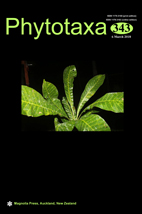Abstract
Diplazium yinchanianum, a new species of Athyriaceae from the Shiwandashan mountains in Guangxi, China, is described and illustrated. This species is morphologically most similar to D. yaoshanense with both having a long creeping rhizome and 1-pinnate laminae with an abruptly reduced apex, but differs from the latter by having oblong laminae with an apical pinna. Molecular phylogenetic analysis based on the plastid matK, rbcL, and trnL-F sequences indicated that the two species are distantly related.

